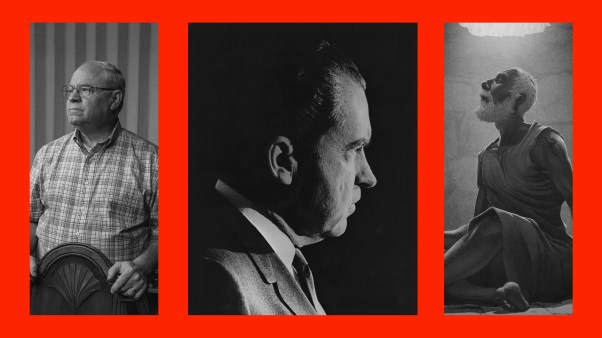After four years of seminary and a brief stint as a campus pastor at one of the largest churches in Raleigh, North Carolina, Charlie Dunn found himself working in retail. He quickly discovered his standard approach to evangelism wouldn’t work in this new environment. “Early on, I would try to get my coworkers to come to church because that’s how I understood my role in evangelism,” Dunn said. “They never came.”
But when he invited them to his house, they started showing up. In the beginning, Dunn and his wife, Abby, invited neighbors and coworkers to join them for a cookout, for their daughter’s first birthday party, and for an indoor soccer match. “They were willing to study the Bible for five hours at a time, grill out, have a drink, and be a family together,” Dunn said.
At the same time, Dunn felt a call to plant a church. But something held him back. “I felt like planters were guys who captivated massive crowds, planted huge churches right off the bat, and were front and center on the speaking and book-writing circuits,” he said. “I wasn’t sure I could achieve that.”
After researching different church plant models, he came to a realization: The small community he was already cultivating could be the seed of a church—albeit, one that broke the church mold to which he was accustomed. In September of 2015, he launch Hub Church, a missional community in South Boston, Massachusetts. About 30 people gathered to share their stories, partake in the Lord’s Supper, and hear Scripture preached.
Today Hub Church has expanded into three separate missional communities. One is plugging in at a neighborhood elementary school, another is building relationships at a government-owned senior living facility, and the third is dedicated to serving an addiction recovery home. While these communities meet together three Sundays a month, they spend the fourth serving their chosen context.
Hub Church and others like it represent a movement of missional communities that has proven especially resilient in post-Christian contexts. Proponents of this model believe it offers a long-overdue expansion of what we mean when we talk about “the local church.”
The History of Missional Communities
The missional movement, of which Hub Church is a part, emerged in the 1990s in several different contexts. In inner city London, Mike Breen began experimenting with smaller church communities. “We saw that these communities were small enough to care for people but not big enough to dare to do mission,” Breen recalled. “We began gathering the small groups into a large Victorian flat. We had dinner and worship going all the time. Then we started going out and doing mission. That was the beginning of the movement.”
Breen was appointed rector of St. Thomas in Sheffield, England, in 1994, where he put his earlier experiments into practice on a larger scale. That initial push of small groups banding together to minister to their community “turned into thousands upon thousands of people in missional communities in a city where less than one percent of people attend church.” In six years, his church became one of the largest in England and one of the fastest-growing in Europe. Each of St. Thomas’s communities serves a different group of people, including artists, gang members, and former Muslims.
Meanwhile a similar movement was building in Australia under the direction of Alan and Deb Hirsch. For these pioneers, missional approaches offered an alternative to the traditional models of church prevalent throughout the West. According to Alan Hirsch, “Because of our radically post-Christian situation, church growth and church planting models formulated for the more churched setting of America did not work in Australia.” In 1997 Alan, Deb, and Michael Frost launched the Forge Mission Training Network in Victoria, Australia, to “train people to live as missionaries in the places they are sent,” according to their website.
Though a few forerunners appeared in the US in the 1990s, the missional community movement did not gain strong traction in North America until the early 2000s. In 2004 Breen moved to the United States to bring the 3DM method across the pond. In Denver, Colorado, Hugh Halter started a missional family in 2002, which became a series of “Tangible Network” communities. He now works with Alan and Deb Hirsch as the national director of Forge America, which launched in 2010.
Jeff Vanderstelt, pastor of Doxa Church in Bellevue, Washington, started thinking about the advantages of missional communities when he was the director of Student Ministries at Willow Creek Community Church in the Chicago area. “We decentralized a very large youth ministry into localized home groups for contextualized mission,” he said. In 2003 Vanderstelt launched Soma Tacoma, a missional community with 23 members, through the Acts 29 Network. “When I started Soma Church,” he said, “I wanted to ensure that everyone believed they were called to be the church and learned to live this out everywhere, every day.”
By 2011 the church had grown to more than 400 members. “As we multiplied, we became a network of missional communities,” said Vanderstelt. In recent years, that network has united with other missional community networks to form the Soma Family of Churches. Nearly 1,000 church planters have learned the ins and outs of missional communities through Soma’s training program, and the family now includes more than 50 churches.
More Than a Small Group
At first blush, missional communities appear to be little more than highly developed small groups. But according to Vanderstelt, there’s a big difference. Traditionally, small groups are optional additions to Sunday morning gatherings, which remain the primary venue of worship and community. But in missional communities, Sunday gatherings supplement “the equipping of the saints for the works of ministry all week long.”
Ben Connelly—who planted The City Church in Fort Worth, Texas, and leads Soma’s church planting residencies—agrees. “From the outside, we may look like a church of small groups. We come together on Sundays and then leave to meet in different forms throughout the week. But the priority of those things is actually flipped on its head,” he said.
Todd Engstrom, pastor of Austin Stone Community Church, believes the difference between small groups and missional communities lies in how each defines success. For small groups, “success is still defined as attendance at an event,” he wrote. But missional communities are successful if they are “redeeming everyday life with gospel intentionality. … A missional community sees itself as a network of relationships with a common mission, rather than being defined by attending an event.”
Breen sees an external focus as the movement’s key distinctive. “It’s about having an outward perspective versus gathering people in,” he said. “It’s always been about sending people out. It requires leaders to have a passion and a vision for mission.”
Many in the US have come to think of their homes as a refuge from the difficulties of the world, but Dhati Lewis, pastor of Blueprint Church in Atlanta, Georgia, encourages people in his church to open up their homes for the sake of mission. “We define life-on-life discipleship as a once-a-week meeting at Starbucks. I don’t understand that,” he said in a panel discussion. “We must reclaim the art of hospitality by using our houses as weapons for the gospel.”
Since missional communities are embedded in neighborhood homes and gathering spots, practitioners are better able to engage others throughout the week. “The non-Christian culture despises the evangelical church right now,” Hugh Halter said. “They’re going to have to run into us in their neighborhoods to like and respect us.”
For Halter, the idea of starting a community emerged from his son Ryan’s severe epilepsy. “Because of his disability, we couldn’t leave the house much,” he said. “Our home became the front line of mission. We had to create simple, reproducible rhythms people could come do with us.”
Twice a month, the Halter family’s community would gather to read Scripture. Once a week, they would throw a party, and every week or two they would serve the neighborhood together.
“We didn’t know we were planting a church,” he said.
In two years, without an official name or any advertising, their meetings grew to four groups—about 45 people total. Many were Starbucks employees, since Halter’s wife worked at one nearby. “We had three natural contexts: the place we had coffee every day, our neighborhood, and our kids’ hockey program,” Halter said. “I always tell people, don’t add anything to your life. See everywhere you are as a mission field.”
Challenges of the Future
Although it may have been trendy at the turn of the century, the missional movement seems to be in a second phase, said Halter. “It’s a way of doing church we will all have to do someday.”
“This is an all-in way of winning your neighborhood. It’s a hard sell. But if the church keeps declining like it is in the US, there won’t be many options left,” he said. “It may be the only way that works 20 to 30 years from now.”
“If you look at post-Christian societies, this is the church model that is sticking,” said Ben Connelly. “In the UK, which has been dominated by the Church of England and Roman Catholicism, missional communities are one of the primary ways in which churches are starting to thrive again. Their example is a strong argument for this type of model in post-Christian America.”
Many people are trading face-to-face relationships for digital connections, and Jeff Vanderstelt sees an opportunity for missional communities to meet neglected relational needs. “As the world becomes virtually networked, people are feeling more isolated. Their online friends may be in the thousands, but they feel alone,” he said. “Because they are made in the image of a Triune God, they long for close, deep community. Millennials especially want the life that a missional community offers.”
Breen believes a family dynamic will play a big role in the days ahead. “The future of missional communities is family on mission,” he said. But he’s not just talking about blood relations. “What the old generation called ‘failure to launch,’ this generation calls extended family. Millennials have a strong desire for an extended family, one that includes both blood and non-blood relationships.” Breen sees a biblical precedent for this paradigm. “I love the idea that when Jesus chooses disciples, he calls them his family. He created his own family on mission. That’s an amazing image to carry into the 21st century.”
But that doesn’t mean missional communities will be an easy sell to church leaders used to different strategies, according to pastor and 3DM board member Jo Saxton. “When you’ve lived in a particular way, you get used to it,” she said in a video interview for Verge. “How do you assess what success looks like [in a missional community]? In a more conventional environment … high attendance is a sign that you’re doing well. Giving is a sign that you’re doing well.” But success in a missional community is harder to measure.
Another difficulty many practitioners fail to take into account is what to do with the kids. “It’s really nice on Sunday morning to take your kids to a meeting where you know they will be taken care of for the next hour and a half, and you can sit and have an adult moment in your week,” said Saxton. “We’ve found that, although people have to let go of these comforts, they discover how to raise their children as a community.”
While missional communities are not expensive financially, they cost tremendous time and energy. Halter estimates commitment to a community can easily take 10 hours a week, even for those outside of leadership. Many people start eagerly in the model, he said, but aren’t willing to reorient their lives. For example, introverts must be willing to stretch out of their comfort zones to build relationships.
Charlie Dunn says the key to survival is to focus on the mission.
“When people lead out of pragmatism rather than the gospel, they burn out,” Dunn said. “If anything but the gospel is at the center of your practice and theology, it’s worthless.”
He warns that the missional community model is so appealing to many church planters, himself included, it can become an idol of sorts. “We want to call people to the message of the gospel—freedom in Christ, through the medium of family—which works in every context,” he said. “Not to a model.”
Kara Bettis is associate features editor at Christianity Today and lives in Boston. Some reporting for this article was conducted by Paul Pastor, author and deacon of spiritual formation at Theophilus Church in Portland, Oregon.
This article originally appeared in CT Pastors’ Guide to New Church Models, originally published in 2017, which offers an overview of the model-rich landscape of church ministry. It can be found at BuildingChurchLeaders.com.









